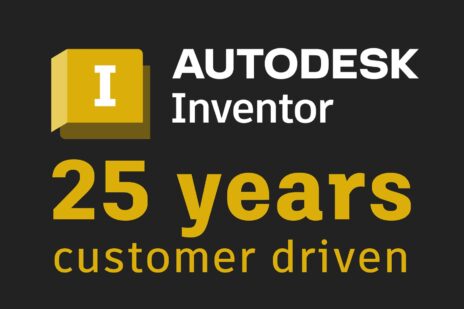
As Inventor’s development cadence ramps up, we’re not only putting in new functionality but also looking at ways to make it easier to move data between releases.
We recently cranked up the Inventor release cadence. Rather than holding everything back for one big release each year, Inventor is now on pace to deliver new functionality every few months. There are major releases (ie new versions) followed by incremental updates that build upon them.
New Inventor functionality is now rolling out every few months. For details on each release, check the What’s New history in the online help.
So far, adoption on these incremental updates has been pretty high. Aside from being easy to access (thank you Autodesk Desktop App!) one reason these have been so popular is that there are no compatibility concerns within a given version. You can move models between the releases (moving from Inventor 2017.3, for example, back to the original release of Inventor 2017) without worrying about data compatibility. That allows you stay up to date with the latest releases while working with others who may not be able to update at the same time. As long as you’re on the same major version it’s no problem.
But what if you want to move up to a new major version when it first comes out? In the CAD world, sharing native data with an older version isn’t that easy. Most 3D parametric CAD tools do a good job of moving data forward, but they can’t send it back. That’s because old versions just don’t know how to handle new kinds of operations that new versions bake into a model. Think of a parametric CAD model like you would a recipe that calls for lots of ingredients. All need to be brought together in the right way and in the right sequence. If the recipe includes new ingredients that you’ve never seen before and don’t have at hand, you can’t follow the steps exactly as defined. It may be okay to stray from a recipe when making a meal, but you just can’t do that in CAD. Precision, accuracy, and reliability are key, so older versions are typically blocked from trying to interpret future formats.
Because of this, updating to a new version of CAD has traditionally entailed a tradeoff. You’d take advantage of all the goodness of a new version, but your collaborators wouldn’t be able to work with the native data you create unless they all move to the same version. Sure, you could kick out a STEP file and share it, but doing so relies on a translation and throws away a lot of the intelligence built into native parts and assemblies.
This year, we’re extending Inventor’s AnyCAD capabilities to help out. AnyCAD has always supported both 2D and 3D as well as Autodesk and non-Autodesk formats. Soon it will also support current and future formats. It will allow a user of an older version of Inventor to reference a future file format into their assembly, providing basic backward compatibility.
AnyCAD has always supported 2D and 3D as well as Autodesk and non-Autodesk formats. We are
now adding future formats also with new support for Inventor 2018.
What does that mean? Well let’s imagine you are working on a design that’s a subcomponent of a larger assembly that someone else is putting together. Let’s say they are in a different division within your company or maybe they are one of your customers. You want to take advantage of Inventor 2018 as soon as it comes out, but your collaborator is on Inventor 2017. With this new capability, you can…
- Create or edit a model in Inventor 2018. Either a part or assembly.
- Use any of the new Inventor 2018 capabilities you wish, including those that were not available in version 2017. Not just the usability improvements but changes that actually define the geometry in new and different ways – extending the start on holes, multiple sheet metal rules, extrude offset from face, etc.
- Save the file(s) in Inventor 2018 format like usual and share with your collaborator.
- Make sure your collaborator is on Inventor 2017.4. This contains the intelligence for being able to reference the 2018 models.
- Your collaborator can use Inventor 2017.4 to reference the 2018 data into an assembly using AnyCAD. They won’t be able to change the parameters for that data inside their old version – version 2017 can’t do everything that 2018 can. But just like with other AnyCAD references they can review properties, run simulations, set up for machining with CAM, or modify the geometry using direct editing. And if you ever modify that design in version 2018, those updates can be automatically accounted for without re-work in 2017 thanks to an associative connection. Your collaborator gets the new file, hits “update” and then everything maps over.
- When that collaborator on Inventor 2017.4 moves up to Inventor 2018 at some point in the future and saves the file, everything is brought up to the same version. From that point onward everything is all in 2018 format and the referenced model acts just like a regular part or assembly.
This video probably does a better job of showing the idea—an Inventor 2018 user creating some designs and another user on Inventor 2017.4 being able to reference them in.
AnyCAD now allows Inventor 2018 models to be referenced into Inventor 2017 assemblies
Maybe you are reviewing what Inventor 2018’s all about and thinking it might be time to move up. As you consider it, remember this time that the new version will create data that isn’t restricted to just that one new version. It can be referenced into version 2017 as well. The idea is to make it easier to help people adopt these major releases just a little bit sooner so they can start taking advantage of all they have to offer.
Jon den Hartog – Sr. Product Manager, Inventor Product Line
jon.denhartog@autodesk.com





